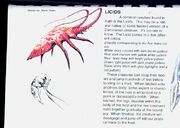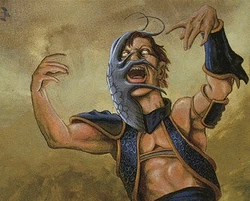| Licid | |
|---|---|
| Creature Type | |
| (Subtype for creature/tribal cards) | |
| Statistics |
12 cards
as of Ikoria: Lair of Behemoths |
| Scryfall Search | |
| type:"Licid" | |
Licids are parasitic or symbiotic beings of a sluglike or insectoid nature with six (generally) limbs and a tail, found on the plane of Rath. The creature type only appeared in the Tempest block.
Storyline

Description of licids in the Tempest style book
Licids blur the definition of "interdependent life form". They live most of their lives as solitary creatures, preying upon rodents and insects.[1] The species is very unfriendly to its own kind and certain breeds are blood enemies. It is believed that Licids are asexual egg layers that leave their young to fend for themselves. Licids can bond with a host (usually a human) and then imbue that creature with some ability. When attached, the Licid's legs sink into the body of the host, and the two creatures gradually meld together at the point of contact. When the Licid leaves the host, it disengages itself without physical harm to either organism. How the Licid benefits from this union is unknown, though it must be important to the creature's life cycle, as every Licid is thought to do this at least once in its life. In some cases, a licid is used by sentient beings for their ability granting capabilities. The Vec use beneficial Licids to enhance their combat skills, or as part of ceremonies. For example, a calming licid might be used to subdue dangerous criminals, or a quickening licid could be used to increase a warrior's speed. Licid skin, bones and tissue are also regularly used by the Vec as cloth, implements and food. However, the potential harm some varieties of Licid can do lead many potential hosts to avoid all contact with them.
Game mechanics
All licids have two abilities; an activated ability that changes the Licid into an aura enchantment with enchant creature, and a static ability that modifies the characteristics of the creature it enchants. Because of this complexity, they are considered a design failure.[2]
Activated ability
The activated ability is always of the form "[mana cost], Tap: [This] loses this ability and becomes an Aura enchantment with enchant creature. Attach it to target creature. You may pay M to end this effect." The use of this ability causes the creature to stop being a creature and instead become an Aura attached to a target creature. This can prevent lethal damage from killing the Licid, and also creates a tapped enchantment, an unusual state for an enchantment that has no effect on its function. This ability also includes a clause for reverting the Licid back to its creature state, which costs one mana of the same color as the Licid (M).
Static ability
The static ability is like that of any normal Aura enchantment, which modifies the characteristics of the creature it enchants either by granting it an additional ability (such as flying) or by modifying its characteristics (such as its controller) or its card types.
List of Licids
- There is an uncommon cycle of licids printed in Tempest, all of which are 1/1 creatures with a casting cost of
M. They are Quickening Licid, Stinging Licid, Leeching Licid, Enraging Licid, and Nurturing Licid.
- There is also an uncommon cycle of licids printed in Stronghold, all of which are all 2/2 creatures with a casting cost of
M. They are Calming Licid, Gliding Licid, Corrupting Licid, Convulsing Licid, and Tempting Licid.
- Two licids were printed in Exodus. These are the uncommon Transmogrifying Licid and the rare Dominating Licid. Transmogrifying Licid is the only Licid artifact creature, and Dominating Licid is the only Licid to have a casting cost requiring two mana of a specific color.
Art
In the card art, licids are always shown attached to a host. At least one non-licid card contains a licid: Mage il-Vec from Exodus. The John Matson illustration on this card was originally commissioned for a licid.[3]
References
- ↑ Pete Venters, Stepping into the Darkness, Dominian Chronicles, The Duelist # 21, 1997
- ↑ Mark Rosewater (November 10, 2003). "Make No Mistake". magicthegathering.com. Wizards of the Coast.
- ↑ Magic Arcana (April 15, 2002). "Ewww... licids". magicthegathering.com. Wizards of the Coast.

